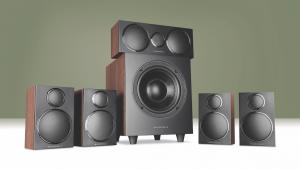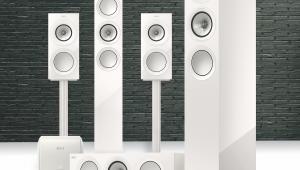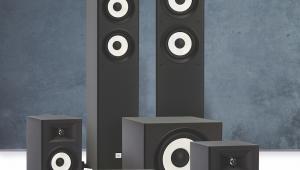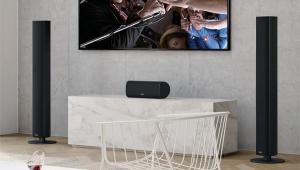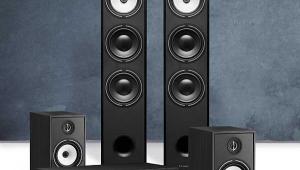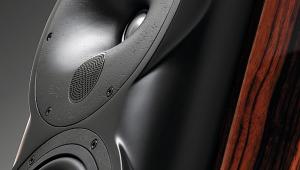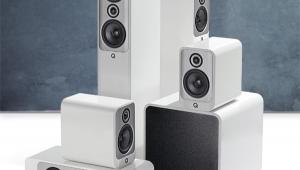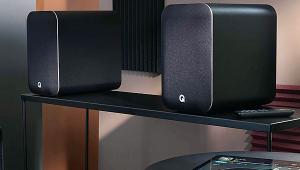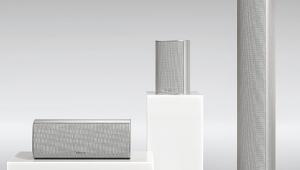Arendal Sound 1961 Series 5.1.2 speaker system review Page 2
All the 1961 models are supplied with magnetic cloth grilles, and are available in matte white or matte black finish. The Tower speakers are also supplied with plinth bar stands and spikes.
Getting Down To Business
With an Arcam AVR850 giving the Arendal speakers plenty of backup (they're only moderately sensitive – 87dB for the Tower, dropping to 84dB for the surround – and have a nominal 4 ohm rating), and with height models used atop the 1961 Towers, it takes little time at all to realise this system is pretty special. The unflustered way it goes about its business, and its neutral tonality, means that film soundtracks (and music) sound clean and detailed. It's a revealing, full-range performance that trades the warmth that some floorstanders offer for transparency. And while the soundstage generated isn't as big as that of Arendal's larger models, it's certainly big enough to fully engage you.
I began with some hooliganistic drum 'n' bass running in stereo to get the juices flowing, and the 1961 Towers seemed up for the party. The roiling, low-frequency waves of Moving Fusion's Turbulence (Tidal FLAC) revealed the speakers' grippy, propulsive nature, and hammered home the benefits of Arendal's four-strong woofer approach. When you're confronted by a loudspeaker whose front baffle is almost all driver, it's perhaps no surprise that it can sound bass-rich, no matter how slender it is.
Switching to movies and the full subwoofer-assisted 5.1.2 monty means those woofers have less work to do, but their presence – across the whole system – is always felt. It's there in the way the Subwoofer 1S and the passive models dovetail together to handle explosive moments, and the authoritative heft the 1961 Centre gives to male voices; it's there in the Arendal system's adept handling of the metallic, grinding score of Chernobyl (Sky Atlantic, Dolby Atmos).
Full-bodied these speakers may be, but they never seem to overemphasise bass/lower mids at the expense of the rest of the frequency range. In the enjoyably daft Vin Diesel actioner Bloodshot (4K Blu-ray), when Guy Pearce is showing his new nanobot-boosted recruit around the rehabilitation centre, there's a tidy balance between lows and highs. The lift doors open and its mechanism slows with a subtle, low-end whoosh, yet the rest of the scene packs crisp Foley effects that slice through like a sharp knife. Pearce's dialogue is forthright and crystal clear, with all his nuances and inflections delivered; he sounds believable rather than boomy.
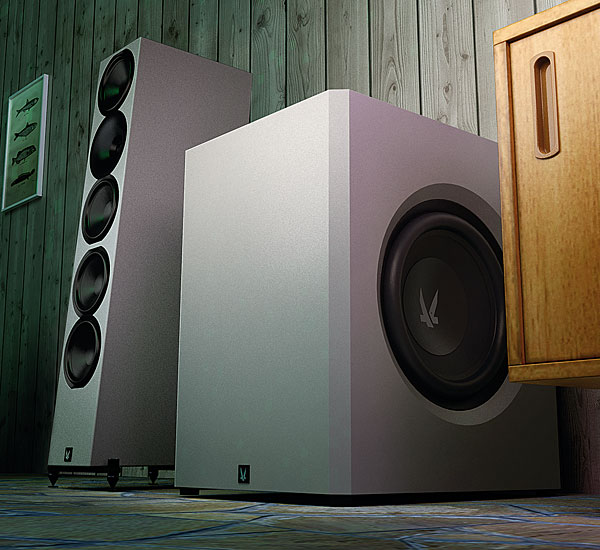
Cut to the Budapest road tunnel set-piece, and the full array gets to strut its stuff, first in the way it conveys the echoey location outside of the villains' car and the confined, almost airless interior within it. The scene is, at first, played to be tense, and the precision of Arendal's system adds to the effect. As flares are thrown, weapons are unholstered and footsteps nervously advance, these sound elements are dotted throughout the soundfield, creating an immersive, pulse-heightening experience. When, inevitably, the fighting starts, the soundmix shifts into an entire other gear, score and LFE channel bursting into life. Superheroic punches are thrown, concrete pillars crumble, bones crack with wince-inducing clarity and swirling nanobots rebuild our hero. The Arendals rise to the challenge easily.
With Atmos material the 1961 Height puts in a good show. I was a bit worried that the under-1m height of the Tower models wouldn't be an ideal pedestal for them, but the enclosures stand reasonably tall themselves, meaning drivers sat above my ear level. These add-ons can create an effective height layer, with clean, distinct effects that have the same snappy attack as the rest of the system. For an authentic, all-encompassing Atmos experience a second pair for the rear of the soundfield would be ideal, but even with just two the system pulls off the magic trick of making sounds come from above. In the Bloodshot tunnel scene, ceiling lights blow out high up, while the storm sequence in Unbroken (4K Blu-ray) finds water raining down.
Helping to create the array's enveloping feel is Arendal's 'TriAxial' surrounds. Despite those additional 3in dipole drivers not being found elsewhere in the system, there's no sense of any timbral mismatch, and these models are potent enough to ensure that whenever a sound designer gets dramatic with the surround channel, you'll hear it. Depending on how your room is setup, placement of these triple-faced speakers might be an issue – so for a traditional monopole design to partner the 1961 Towers, check out Arendal's €700-per-pair two-way Bookshelf model.
The Subwoofer 1S, meanwhile, is a rock-solid partner for this setup. It's feature-rich for an €800 woofer, and its performance is above-par too. Arendal's large driver and 550W amp stage combine to reach low and go loud. With Interstellar (4K Blu-ray), my seating position was given a wonderfully brutal pummelling as Matthew McConaughey went on his black hole joyride, the subwoofer creating a room-filling, low-end rumble that seemed to enlarge the soundstage tenfold.
A Chip Off The Old Block
Loudspeakers that don't dominate a room are always welcome, and Arendal's slimmed-down series should give the brand more mainstream appeal. Yet even while setting its sights a little lower price-wise, the company hasn't altered its approach. This system has the sonic maturity of its siblings, favouring neutrality and transparency, and is built to handle the dynamic, full-range approach of film soundtracks. The payoff is that they're power hungry, needing quality amplification to really wake them. Match them with sufficient power, though, and they'll leave you smiling.
HCC Verdict
Arendal Sound 1961 Series 5.1.2
Price: €4,300
www.arendalsound.eu
We say: Entry-level for Arendal, but by no means a budget setup, the 1961 Series offers well balanced, dynamic and revealing sonics. Buyers won't be disappointed.
Overall: 4.5/5
Specification
1961 Tower
DRIVE UNITS: 1 x 28mm tweeter; 2 x 5.5in midbass; 2 x 5.5in woofers ENCLOSURE: Rear-vented (supplied with vent bung for sealed operation) FREQUENCY RESPONSE (CLAIMED): 39Hz-20kHz (vented); 49Hz-20kHz (sealed) SENSITIVITY (CLAIMED): 87dB POWR HANDLING (CLAIMED): 350W DIMENSIONS (off feet): 837(h) x 163(w) x 285(d)mm WEIGHT: 17.9kg
1961 Center
DRIVE UNITS: 1 x 28mm tweeter; 2 x 5.5in midbass ENCLOSURE: Sealed FREQUENCY RESPONSE (CLAIMED): 73Hz-20kHz SENSITIVITY (CLAIMED): 87dB POWR HANDLING (CLAIMED): 250W DIMENSIONS: 163(h) x 425(w) x 150(d)mm WEIGHT: 7.25kg
1961 Surround
DRIVE UNITS: 1 x 28mm tweeter; 1 x 5.5in midbass; 2 x 3in full-range ENCLOSURE: Sealed, TriAxial FREQUENCY RESPONSE (CLAIMED): 75Hz-20kHz SENSITIVITY (CLAIMED): 84dB POWR HANDLING (CLAIMED): 180W DIMENSIONS: 287(h) x 163(w) x 185(d)mm WEIGHT: 6kg
1961 Height
DRIVE UNITS: 1 x 28mm tweeter; 1 x 5.5in midbass ENCLOSURE: Sealed, with 10-degree baffle angle FREQUENCY RESPONSE (CLAIMED): 75Hz-20kHz SENSITIVITY (CLAIMED): 84dB POWR HANDLING (CLAIMED): 180W DIMENSIONS: 149(h) x 183(w) x 283(d)mm WEIGHT: 4.4kg
1961 Subwoofer 1S (subwoofer)
DRIVE UNITS: 1 x 12.2in long fibre pulp driver ENCLOSURE: Sealed FREQUENCY RESPONSE (CLAIMED): 19Hz-200Hz (+/-3dB, EQ1); 26Hz-200Hz (+/-3dB, EQ2) ONBOARD POWER (CLAIMED): 550W RMS REMOTE CONTROL: No DIMENSIONS (without feet): 427(h) x 315(w) x 415(d)mm WEIGHT: 20kg
FEATURES: Low-level stereo phono input; LFE phono input; low-level stereo phono output; Avalanche 550IQ digital amplifier; LCD display menu control; low-pass filter control with adjustable slopes; subsonic filter control with adjustable slopes; 2 x EQ modes and three-band parametric EQ with Q factor control; variable phase and signal invert; adjustable auto wake and on-time setting; 12V trigger
 |
Home Cinema Choice #351 is on sale now, featuring: Samsung S95D flagship OLED TV; Ascendo loudspeakers; Pioneer VSA-LX805 AV receiver; UST projector roundup; 2024’s summer movies; Conan 4K; and more
|




